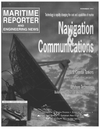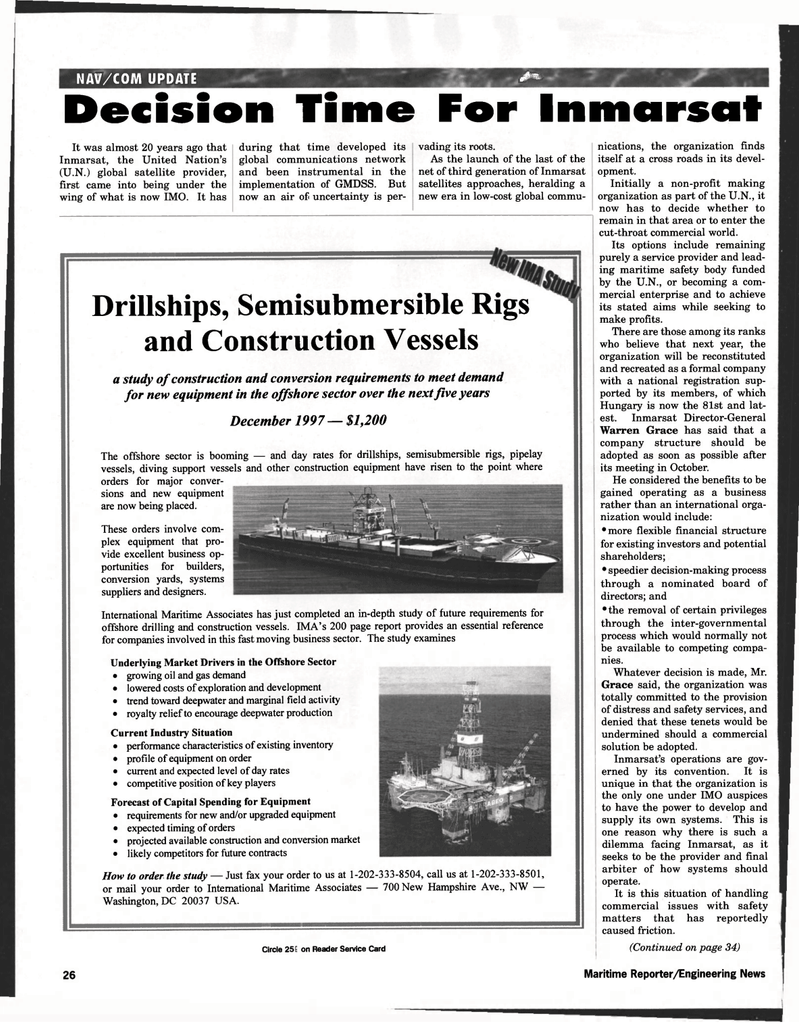
Page 28: of Maritime Reporter Magazine (November 1997)
Read this page in Pdf, Flash or Html5 edition of November 1997 Maritime Reporter Magazine
NAV/COM UPDATE Jim-
Decision Time For Inmarsat
It was almost 20 years ago that
Inmarsat, the United Nation's (U.N.) global satellite provider, first came into being under the wing of what is now IMO. It has during that time developed its global communications network and been instrumental in the implementation of GMDSS. But now an air of uncertainty is per- vading its roots.
As the launch of the last of the net of third generation of Inmarsat satellites approaches, heralding a new era in low-cost global commu-
Drillships, Semisubmersible Rigs and Construction Vessels a study of construction and conversion requirements to meet demand for new equipment in the offshore sector over the next five years
December 1997—$1,200
The offshore sector is booming — and day rates for drillships, semisubmersible rigs, pipelay vessels, diving support vessels and other construction equipment have risen to the point where orders for major conver- sions and new equipment are now being placed.
These orders involve com- plex equipment that pro- vide excellent business op- portunities for builders, conversion yards, systems suppliers and designers.
International Maritime Associates has just completed an in-depth study of future requirements for offshore drilling and construction vessels. IMA's 200 page report provides an essential reference for companies involved in this fast moving business sector. The study examines
Underlying Market Drivers in the Offshore Sector • growing oil and gas demand • lowered costs of exploration and development • trend toward deepwater and marginal field activity • royalty relief to encourage deepwater production
Current Industry Situation • performance characteristics of existing inventory • profile of equipment on order • current and expected level of day rates • competitive position of key players
Forecast of Capital Spending for Equipment • requirements for new and/or upgraded equipment • expected timing of orders • projected available construction and conversion market • likely competitors for future contracts
How to order the study — Just fax your order to us at 1-202-333-8504, call us at 1-202-333-8501, or mail your order to International Maritime Associates — 700 New Hampshire Ave., NW —
Washington, DC 20037 USA.
Circle 245 on Reader Service Card 26 nications, the organization finds itself at a cross roads in its devel- opment.
Initially a non-profit making organization as part of the U.N., it now has to decide whether to remain in that area or to enter the cut-throat commercial world.
Its options include remaining purely a service provider and lead- ing maritime safety body funded by the U.N., or becoming a com- mercial enterprise and to achieve its stated aims while seeking to make profits.
There are those among its ranks who believe that next year, the organization will be reconstituted and recreated as a formal company with a national registration sup- ported by its members, of which
Hungary is now the 81st and lat- est. Inmarsat Director-General
Warren Grace has said that a company structure should be adopted as soon as possible after its meeting in October.
He considered the benefits to be gained operating as a business rather than an international orga- nization would include: •more flexible financial structure for existing investors and potential shareholders; • speedier decision-making process through a nominated board of directors; and •the removal of certain privileges through the inter-governmental process which would normally not be available to competing compa- nies.
Whatever decision is made, Mr.
Grace said, the organization was totally committed to the provision of distress and safety services, and denied that these tenets would be undermined should a commercial solution be adopted.
Inmarsat's operations are gov- erned by its convention. It is unique in that the organization is the only one under IMO auspices to have the power to develop and supply its own systems. This is one reason why there is such a dilemma facing Inmarsat, as it seeks to be the provider and final arbiter of how systems should operate.
It is this situation of handling commercial issues with safety matters that has reportedly caused friction. (Continued on page 34)
Maritime Reporter/Engineering News!

 27
27

 29
29
